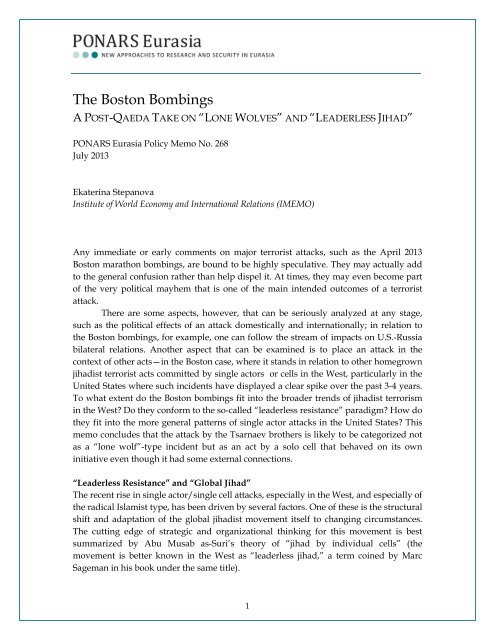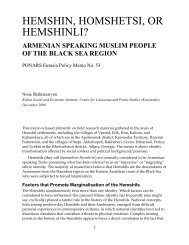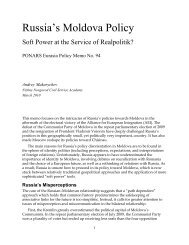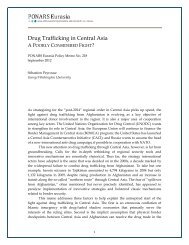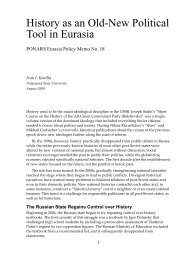View the Policy Memo (PDF) - PONARS Eurasia
View the Policy Memo (PDF) - PONARS Eurasia
View the Policy Memo (PDF) - PONARS Eurasia
Create successful ePaper yourself
Turn your PDF publications into a flip-book with our unique Google optimized e-Paper software.
The Boston Bombings<br />
A POST-QAEDA TAKE ON “LONE WOLVES” AND “LEADERLESS JIHAD”<br />
<strong>PONARS</strong> <strong>Eurasia</strong> <strong>Policy</strong> <strong>Memo</strong> No. 268<br />
July 2013<br />
Ekaterina Stepanova<br />
Institute of World Economy and International Relations (IMEMO)<br />
Any immediate or early comments on major terrorist attacks, such as <strong>the</strong> April 2013<br />
Boston marathon bombings, are bound to be highly speculative. They may actually add<br />
to <strong>the</strong> general confusion ra<strong>the</strong>r than help dispel it. At times, <strong>the</strong>y may even become part<br />
of <strong>the</strong> very political mayhem that is one of <strong>the</strong> main intended outcomes of a terrorist<br />
attack.<br />
There are some aspects, however, that can be seriously analyzed at any stage,<br />
such as <strong>the</strong> political effects of an attack domestically and internationally; in relation to<br />
<strong>the</strong> Boston bombings, for example, one can follow <strong>the</strong> stream of impacts on U.S.-Russia<br />
bilateral relations. Ano<strong>the</strong>r aspect that can be examined is to place an attack in <strong>the</strong><br />
context of o<strong>the</strong>r acts—in <strong>the</strong> Boston case, where it stands in relation to o<strong>the</strong>r homegrown<br />
jihadist terrorist acts committed by single actors or cells in <strong>the</strong> West, particularly in <strong>the</strong><br />
United States where such incidents have displayed a clear spike over <strong>the</strong> past 3-4 years.<br />
To what extent do <strong>the</strong> Boston bombings fit into <strong>the</strong> broader trends of jihadist terrorism<br />
in <strong>the</strong> West? Do <strong>the</strong>y conform to <strong>the</strong> so-called “leaderless resistance” paradigm? How do<br />
<strong>the</strong>y fit into <strong>the</strong> more general patterns of single actor attacks in <strong>the</strong> United States? This<br />
memo concludes that <strong>the</strong> attack by <strong>the</strong> Tsarnaev bro<strong>the</strong>rs is likely to be categorized not<br />
as a “lone wolf”-type incident but as an act by a solo cell that behaved on its own<br />
initiative even though it had some external connections.<br />
“Leaderless Resistance” and “Global Jihad”<br />
The recent rise in single actor/single cell attacks, especially in <strong>the</strong> West, and especially of<br />
<strong>the</strong> radical Islamist type, has been driven by several factors. One of <strong>the</strong>se is <strong>the</strong> structural<br />
shift and adaptation of <strong>the</strong> global jihadist movement itself to changing circumstances.<br />
The cutting edge of strategic and organizational thinking for this movement is best<br />
summarized by Abu Musab as-Suri’s <strong>the</strong>ory of “jihad by individual cells” (<strong>the</strong><br />
movement is better known in <strong>the</strong> West as “leaderless jihad,” a term coined by Marc<br />
Sageman in his book under <strong>the</strong> same title).<br />
1
The Boston marathon bombings are commonly described as a case of ei<strong>the</strong>r<br />
“leaderless resistance” or ”lone wolf” terrorism (or both). While <strong>the</strong>se two concepts are<br />
at times used interchangeably, <strong>the</strong>y generally differ in regards to <strong>the</strong> main type of actor.<br />
“Leaderless resistance” mainly refers to terrorism as a network strategy and<br />
organizational pattern consciously adopted, often under pressure, by loose networks of<br />
cells and individuals to streng<strong>the</strong>n asymmetrical advantages vis-à-vis hierarchicallystructured<br />
opponents. “Lone wolf” terrorism implies attacks by stand-alone individuals<br />
or cells acting independently from any group or network. It is not surprising that <strong>the</strong><br />
two phenomena are often confused in cases such as <strong>the</strong> Boston bombings. This is partly<br />
due to a lack of information about a cell’s links in <strong>the</strong> early stages of an investigation,<br />
but it is also due to <strong>the</strong> particular difficulties of establishing <strong>the</strong> nature and connections<br />
of someone who acts outside a formal organizational framework and lacks traditional<br />
leads associated with <strong>the</strong> latter. In part, this confusion results from a genuine overlap<br />
between “leaderless resistance” and “lone wolf” terrorism, especially in <strong>the</strong> global<br />
jihadist movement.<br />
While today “leaderless resistance” is commonly associated with <strong>the</strong> global<br />
jihadist movement, <strong>the</strong> concept was originally developed by <strong>the</strong> extreme right in <strong>the</strong> late<br />
1980s and early 1990s. What its godfa<strong>the</strong>r, U.S. white supremacist Louis Beam, had in<br />
mind were very flat networks, with a complete absence of top-down authority. 1<br />
“Leaderless resistance” was defined as a matter of conscious organizational choice in<br />
favor of a strategy that “allows for and encourages individuals or small cells to engage<br />
in acts of political violence entirely independent of any hierarchy of leadership…” 2<br />
While Beam’s original concept encompassed “lone wolf” attacks by stand-alone<br />
individuals (and applies to high-profile acts of right-wing terrorism, such as <strong>the</strong><br />
Oklahoma City and <strong>the</strong> Atlanta bombings in <strong>the</strong> United States in <strong>the</strong> mid-1990s, as well<br />
as <strong>the</strong> 2011 Oslo attacks), his main hopes were vested in a multiple-cell leaderless<br />
structure—hopes that never materialized for <strong>the</strong> far right.<br />
The concept of a multiple-cell leaderless movement has been more successfully<br />
applied by radical environmentalists, notably <strong>the</strong> Earth Liberation Front (ELF). With no<br />
centralized organization, leadership, or membership roll, ELF violence has been less<br />
deadly than mass-casualty attacks by stand-alone right-wing terrorists, but <strong>the</strong> network<br />
emphasizes sabotage, resulting in heavy property damage, and has achieved a high<br />
frequency of attacks (100 per year on average in <strong>the</strong> late 1990s and early 2000s). The<br />
concept is also sometimes applied retrospectively to anarchists as a highly decentralized<br />
movement built upon semi-autonomous cells and voluntary associations. While acts of<br />
anarchist terrorism (including high-profile political assassinations in <strong>the</strong> past) often<br />
resulted from spontaneous individual actions with <strong>the</strong> help of a few friends, “leaderless<br />
resistance” should only be projected onto that movement with care; for anarchists <strong>the</strong><br />
“leaderless” impulse was not inherently linked to violence in <strong>the</strong> first place but reflected<br />
<strong>the</strong>ir general strategic, organizational, and ideological preferences.<br />
1 Louis Beam, “Leaderless Resistance,” The Seditionist, No. 12, 1992.<br />
2 Paul Joosse, “Leaderless Resistance and Ideological Inclusion: The Case of <strong>the</strong> Earth Liberation Front,”<br />
Terrorism and Political Violence 19 (2007): 351-368.<br />
2
At present, “leaderless resistance” is primarily applied to <strong>the</strong> al-Qaeda-generated<br />
“global jihad.” While some disagree with this usage completely, o<strong>the</strong>rs, including this<br />
author, disagree only in part, claiming that not all that is understood or meant as global<br />
jihad fits <strong>the</strong> pattern of “leaderless resistance.” While <strong>the</strong> movement is a complex<br />
structure and more an exception than <strong>the</strong> rule in several ways, it combines some of <strong>the</strong><br />
key network features with select pre-network and post-network elements and is <strong>the</strong><br />
most well-known transnational terrorist network. In contrast to locally-based groups<br />
who ei<strong>the</strong>r combine nationalism with religious extremism or are driven by nationalist<br />
aspirations (and thus are likely to mirror more hierarchical structures of nation-states),<br />
this supranational movement is guided by a universalist religious ideology that in<br />
principle does not favor strict hierarchies (unlike totalitarian cults). To what extent, and<br />
to which layer of global jihad, is “leaderless resistance” applicable depends on how one<br />
understands <strong>the</strong> movement and its evolution in organizational terms. For brevity’s sake,<br />
let us confine ourselves to two main approaches.<br />
The regionalization approach has prevailed in mainstream U.S. and Western<br />
discourses since <strong>the</strong> late 2000s. It disaggregates “global jihad” into three levels. First, it<br />
leaves some direct strategic command role for “al-Qaeda Central” centered in Pakistan<br />
and Afghanistan but acknowledges its declining role. Second, it argues that <strong>the</strong><br />
movement’s center of gravity has shifted toward several organizationally coherent<br />
regional affiliates in Muslim regions—to “al-Qaedas” in <strong>the</strong> Arabian Peninsula, Iraq, <strong>the</strong><br />
lands of <strong>the</strong> Islamic Maghreb, East Africa, and Sou<strong>the</strong>ast Asia. The third level is formed<br />
by al-Qaeda’s “ideological adherents”—small cells and individuals who “know <strong>the</strong><br />
group only through its ideology to carry out violence in its name.” 3 The rise of such<br />
homegrown cells is interpreted as a sign of ei<strong>the</strong>r <strong>the</strong> movement’s capacity to adapt to<br />
changing circumstances or of al-Qaeda’s organizational degradation (resulting primarily<br />
from counterterrorist pressure by <strong>the</strong> United States and its allies).<br />
The post-Qaeda approach denies residual strategic command function for <strong>the</strong> al-<br />
Qaeda core beyond a symbolic and/or ideological role. It questions <strong>the</strong> role of regional<br />
affiliates as al-Qaeda’s main successors and centers of gravity, arguing that most of <strong>the</strong>m<br />
have strong homegrown roots and promote agendas inextricably tied to respective<br />
regional or local conflicts, while <strong>the</strong>ir pledges of loyalty to al-Qaeda are more nominal<br />
than substantive. Instead, a looser network of smaller cells, active in over 70 countries<br />
and promoting an explicitly globalist agenda, is seen as <strong>the</strong> cutting edge and <strong>the</strong> main<br />
driving force of global jihad. In contrast to groups tied to specific local and regional<br />
contexts in <strong>the</strong> Middle East, Asia, or Africa, this type of cell is truly “extraterritorial” in<br />
outlook and goals, with most of <strong>the</strong>m emerging in Western ra<strong>the</strong>r than Muslim states.<br />
These cells display diverse radicalization paths and are not linked to one ano<strong>the</strong>r in any<br />
formal way, but <strong>the</strong>y share <strong>the</strong> ideology of global jihad and toge<strong>the</strong>r form—and see<br />
<strong>the</strong>mselves as part of—an adaptive and resilient transnational network-type movement.<br />
3 “National Strategy for Counterterrorism” (Washington D.C.: The White House), June 2011.<br />
3
Despite its marginality, this movement can still pose a serious terrorist threat to<br />
international security.<br />
Whichever of <strong>the</strong> two approaches one follows, it is <strong>the</strong> micro-cell level to which<br />
elements of “leaderless resistance” apply. The movement does not recruit into a preexisting<br />
framework but encourages people to start <strong>the</strong>ir own cells to fur<strong>the</strong>r its ends;<br />
<strong>the</strong>re is little or no intra-movement communication between cells; <strong>the</strong> idea of starting a<br />
violent cell appeals as much to young males’ desire for glory and <strong>the</strong>ir personal<br />
conscience as to <strong>the</strong>ir political or ideological beliefs. This list of characteristics is actually<br />
a description of <strong>the</strong> ELF (see Joosse 2007), but it equally applies to <strong>the</strong> micro-cell level of<br />
global jihad, if not to <strong>the</strong> movement’s dispersed ideological and strategic leaders nor its<br />
regional affiliates.<br />
“Lone Wolves” and “Global Jihad”<br />
While “leaderless resistance” originates from an organization-centered perspective,<br />
“lone wolves” act outside organizational frameworks.<br />
On <strong>the</strong> one hand, “lone wolf” terrorism remains a relatively marginal<br />
phenomenon. The absolute majority of terrorist attacks are carried out by organized<br />
groups. The number of incidents plotted or carried out by “lone wolves” is miniscule:<br />
<strong>the</strong>y make up less than 1.8 percent of terrorist attacks in Western states between 1968–<br />
2010. Single actors display less destructive capacity, sustainability, and longevity. With<br />
<strong>the</strong> exception of several mass-casualty attacks, acts of “lone wolf” terrorism are less<br />
deadly: <strong>the</strong>y have an average lethality of 0.6 deaths per incident, a statistic that has not<br />
appeared to increase over time.<br />
On <strong>the</strong> o<strong>the</strong>r hand, “lone-wolf” jihadist terrorism in <strong>the</strong> West shows some<br />
marked specifics. Islamist terrorists, who only became a significant issue from <strong>the</strong> 1980s<br />
and early 1990s, already account for 15 percent of <strong>the</strong> total number of single-actor<br />
attacks in <strong>the</strong> West over <strong>the</strong> past 40 years, second only to right-wing extremists with 17<br />
percent. 4 “Lone wolf” attacks also account for a much higher proportion of global jihad<br />
incidents, compared to o<strong>the</strong>r types of terrorist incidents: 14 percent of all plots and<br />
attacks by jihadist actors in Western Europe between 1995 and 2012. 5 Single-actor<br />
jihadist incidents aim at more casualties, as half of all plots involve mass casualty<br />
bombings. Also, while throughout <strong>the</strong> 2000s a gradual increase in “lone wolf” terrorist<br />
incidents mostly affected Western Europe, in <strong>the</strong> late 2000s and early 2010s, jihadist<br />
plots and attacks of this type also increased in <strong>the</strong> United States. Out of 40 such attacks<br />
committed or prevented in <strong>the</strong> United States between 2001 and 2011, over half occurred<br />
between 2009–2010. In 2010, CIA director Leon Panetta described “lone-wolf” terrorism<br />
as <strong>the</strong> main terrorist threat to <strong>the</strong> United States.<br />
There are enough cases of “lone wolf” attacks to give rise to typologies of single<br />
actor terrorism, jihadist or o<strong>the</strong>rwise (see, for example, works by Petter Nesser and<br />
4 Ramón Spaaij, “Understanding Lone Wolf Terrorism: Global Patterns, Motivations and Prevention,”<br />
Springer Briefs in Criminology (Dordrecht; Heidelberg; London; New York: Springer), 2012.<br />
5 Petter Nesser, “Single Actor Terrorism: Scope, Characteristics and Explanations,” Perspectives on Terrorism<br />
6, no. 6 (2012).<br />
4
Raffaello Pantucci). The main distinction usually made is that between pure “lone<br />
wolves” and so-called solo terrorists. “Lone wolves” act entirely on <strong>the</strong>ir own—for<br />
example, <strong>the</strong> Fort Hood shooting in 2009 by Maj. Nidal M. Hasan, <strong>the</strong> stabbing in 2010 of<br />
a British MP by Roshonara Choudhry, and <strong>the</strong> plots by Khalid Aldawsari in 2011 to<br />
bomb former U.S. president George W. Bush’s Dallas home as well as <strong>the</strong> homes of<br />
former Abu Ghraib guards. In contrast, “solo terrorists” have some operational,<br />
financing, training, or o<strong>the</strong>r network ties and connections. They are, in turn, divided into<br />
those who still act on <strong>the</strong>ir own initiative (Abdulhakim Muhammad, who was<br />
responsible for <strong>the</strong> 2009 shooting at a recruitment office in Little Rock, Arkansas), and<br />
those who act in close cooperation with a broader network (Uma Faruk Abdulmutallab,<br />
who tried to bring down a Detroit-bound jetliner with a suicide bomb in 2009, and Faisal<br />
Shahzad, who in 2010 planted a car bomb in New York City’s Times Square). In practice,<br />
however, it is not always easy or possible to make a distinction between “lone wolves”<br />
and “solo actors,” especially at earlier stages of an investigation.<br />
While <strong>the</strong> recent trend in jihadist terrorism in <strong>the</strong> West points to some increase in<br />
“lone wolf” attacks, as compared to attacks by single actors (cells) with some network<br />
connections, this has ambiguous implications. The good news is that purely “lone”<br />
operations demand a lot in terms of skills and abilities, usually producing a mismatch<br />
between qualification and ambition that usually results in failure. The bad news is that<br />
tracking down “lone wolf” terrorists is particularly problematic, as <strong>the</strong>se individuals or<br />
cells are generally not in contact with similar actors or organized groups, do not<br />
necessarily get external training, and often acquire <strong>the</strong>ir weapons and materials<br />
independently and from open sources. Even more problematic is that few single actor<br />
terrorists are real “loners.” Despite a recent spike in “lone wolf” incidents, <strong>the</strong> dominant<br />
type of jihadist terrorism in <strong>the</strong> West remains solo terrorism, with at least some<br />
connections beyond virtual ones. Often, even what at first seems to be a “lone wolf”<br />
tends to reveal a more complex pattern of “network agent” terrorism, as <strong>the</strong> cell’s<br />
various connections are gradually unraveled—a good example here is <strong>the</strong> “Leeds cell,”<br />
which was responsible for <strong>the</strong> 2005 London bombings. Or, following a broader typology<br />
of “homegrown terrorism” in <strong>the</strong> West, what at first appears as an internal-autonomous<br />
actor often turns out to be an example of internal-affiliated terrorism.<br />
The Boston Cell<br />
One of <strong>the</strong> main criteria for single actor typologies in terrorism are <strong>the</strong> external<br />
connections of a mini-cell or one-man cell. When <strong>the</strong>re is a shortage of connections, any<br />
links become crucial. The chief suspects in <strong>the</strong> Boston Marathon attacks—<strong>the</strong> Tsarnaev<br />
bro<strong>the</strong>rs—might or might not have acted as an integrated part of a larger network, but<br />
<strong>the</strong>y are certainly part of a larger phenomenon, particularly in <strong>the</strong> United States.<br />
However, <strong>the</strong> exact type of <strong>the</strong> Boston cell can only be finally established after <strong>the</strong> facts,<br />
nature, and scale of its connections are clarified.<br />
At first, <strong>the</strong> Tsarnaev suspects were commonly referred to as a “lone wolf” cell.<br />
The surviving bro<strong>the</strong>r claims <strong>the</strong>y acted alone. The FBI cautiously confirmed that <strong>the</strong><br />
evidence points to “homegrown violent extremists” acting “in retribution for <strong>the</strong> wars<br />
5
<strong>the</strong> United States waged in Iraq and Afghanistan.” O<strong>the</strong>r similarities with previous post-<br />
9/11 attacks of this type abound. The cell was formed by young, U.S.-based, and<br />
relatively integrated first generation migrants of unexceptional social background. The<br />
older bro<strong>the</strong>r held a green card, while <strong>the</strong> younger was a naturalized U.S. citizen since<br />
2012. No direct connections to known extremist groups were found by <strong>the</strong> CIA or <strong>the</strong><br />
FBI, who had looked into <strong>the</strong> matter upon a lead from <strong>the</strong> Russian government. Nor was<br />
<strong>the</strong>re anything new in having a suspect that had been or was under investigation by U.S.<br />
security agencies end up plotting and committing a terrorist attack—<strong>the</strong>re have been at<br />
least four such cases in <strong>the</strong> United States since 9/11. The suspects were hardly wellversed<br />
Islamists in <strong>the</strong> religious sense, but one or both of <strong>the</strong>m were clearly inspired by<br />
<strong>the</strong> global jihadist abhorrence of U.S. actions in <strong>the</strong> Muslim world, specifically in Iraq<br />
and Afghanistan. Domestic radicalizing influences and connections in <strong>the</strong> United States,<br />
such as a potential radicalizing influence from one or more individuals and/or by<br />
previous jihadist terrorism cases, need to be fur<strong>the</strong>r explored. The Tsarnaev cell was not<br />
<strong>the</strong> first case in which Cambridge mosque-goers faced terrorism charges in <strong>the</strong> United<br />
States or abroad. While it remains to be seen how <strong>the</strong> suspects acquired weapons,<br />
explosives, and funding, one of <strong>the</strong>m bought fireworks from <strong>the</strong> same Phantom<br />
Fireworks company that sold fireworks to Times Square plotter Faisal Shahzad.<br />
Against <strong>the</strong>se similarities, <strong>the</strong>re are two distinct characteristics specific to <strong>the</strong><br />
Boston cell that do not exactly fit <strong>the</strong> pattern of previous single actor jihadist terrorism in<br />
<strong>the</strong> United States.<br />
First, <strong>the</strong> heavier-than-usual damage caused by <strong>the</strong> attack is atypical for single<br />
actor jihadist terrorist acts in <strong>the</strong> West. The Boston attack killed three people on <strong>the</strong> spot<br />
and injured over 260—an unprecedented number of casualties for a post-9/11 jihadist<br />
attack on U.S. soil. Some previous post-9/11 plots in <strong>the</strong> United States involved larger<br />
volumes of explosives but were not successful. While half of all plots of <strong>the</strong>se type in <strong>the</strong><br />
West involve plans to cause mass casualties, very few lead to actual mass-casualty<br />
attacks. In fact, <strong>the</strong>re were only three such previous cases after 2001: <strong>the</strong> 2004 Madrid<br />
bombings, <strong>the</strong> 2005 London bombings, and <strong>the</strong> 2009 Fort Hood shooting (<strong>the</strong> fourth<br />
most lethal terrorist attack in contemporary U.S. history). In all three cases, some degree<br />
of specialized expertise or professional connections was in place. This record, coupled<br />
with some indications of a higher degree of sophistication in <strong>the</strong> Boston explosive<br />
devices than what one can get from Internet manuals, suggest <strong>the</strong> presence of some<br />
specialized training or qualification in <strong>the</strong> Tsarnaevs’ case, even despite some possible<br />
elements of spontaneity (after <strong>the</strong> Boston attacks, <strong>the</strong> bro<strong>the</strong>rs were reported to have<br />
impulsively contemplated ano<strong>the</strong>r bombing at Times Square).<br />
Second, all previous single actor jihadist incidents in <strong>the</strong> United States have<br />
involved some link to ei<strong>the</strong>r Iraq and Afghanistan-Pakistan as <strong>the</strong>aters of U.S. direct<br />
military and security involvement (or, to use jihadist terminology, “open fronts” of<br />
“liberation wars”) or at least to areas where U.S. covert involvement has taken place<br />
(such as Yemen). These links went beyond general inspiration or declared justification<br />
for an attack: <strong>the</strong>y involved ei<strong>the</strong>r suspects of Afghan or Pakistani-American origin,<br />
including those who sought some direct training in <strong>the</strong>se countries, or those, like Hasan,<br />
6
with first-hand experience of <strong>the</strong> wars in Iraq and Afghanistan. For such U.S.-based<br />
jihadists, <strong>the</strong> United States forms an obvious end-target.<br />
In <strong>the</strong> case of <strong>the</strong> Tsarnaev bro<strong>the</strong>rs, due to <strong>the</strong>ir ethnicity, country of origin, and<br />
<strong>the</strong> older bro<strong>the</strong>r’s six-month trip to <strong>the</strong> North Caucasus in <strong>the</strong> first half of 2012, <strong>the</strong><br />
main external (foreign) source of <strong>the</strong> cell’s links explored by <strong>the</strong> U.S. government was<br />
<strong>the</strong> Russian Caucasus and, more specifically, potential connections to <strong>the</strong><br />
“underground” in Dagestan where <strong>the</strong> United States has not had direct or covert<br />
security involvement. So far, investigators found no operational or o<strong>the</strong>r substantive<br />
link between <strong>the</strong> Tsarnaevs to organized militant groups in <strong>the</strong> North Caucasus, despite<br />
<strong>the</strong> older bro<strong>the</strong>r’s trip to <strong>the</strong> region. In Dagestan itself, it is a rare case when an official<br />
account by <strong>the</strong> republic’s Ministry of Internal Affairs coincides with that of <strong>the</strong><br />
underground “Command of <strong>the</strong> Mujahideen of <strong>the</strong> Caucasus Emirate’s Dagestan<br />
Province,” but both deny that <strong>the</strong> Tsarnaevs had any contact with <strong>the</strong> local<br />
“underground,” with <strong>the</strong> rebels even stressing that <strong>the</strong> “Mujahedeen in <strong>the</strong> Caucasus are<br />
at war with Russia not <strong>the</strong> United States.” This is not surprising, as even in <strong>the</strong> context of<br />
<strong>the</strong> post-9/11 war on terrorism, <strong>the</strong> U.S. policy on conflict and terrorism in <strong>the</strong> North<br />
Caucasus can by no means be described as one favoring pro-government authorities<br />
<strong>the</strong>re. But some connections between <strong>the</strong> Tsarnaevs to <strong>the</strong> radical environment may<br />
exist. Take, for example, William Plotnikov, a Canadian ex-boxer turned Islamist radical;<br />
after his arrest in Dagestan in 2010 it was found that he had discussed jihad over e-mail<br />
with <strong>the</strong> older Tsarnaev, allegedly prompting Russia’s first alert/info request to <strong>the</strong><br />
United States. However, one problem with such connections is that Plotnikov and o<strong>the</strong>r<br />
alleged contacts of <strong>the</strong> Tsarnaevs appear to have been killed back in 2012. In fact,<br />
connections of this type—a few foreign contacts and visits to conflict-torn regions for<br />
ideological inspiration, sometimes also in hope to get some training, are quite common<br />
for most homegrown jihadists in <strong>the</strong> West today, with one critical nuance: <strong>the</strong>se are<br />
normally connections/trips to internationalized jihadist “open fronts”<br />
(Afghanistan/Pakistan, Iraq, Yemen, and Somalia). Leading strategic thinkers of global<br />
jihad, such as Anwar al-Awlaki or Abu Musab as-Suri, also normally distinguish “open<br />
fronts” and extraterritorial individual-type jihadists based in <strong>the</strong> West from<br />
local/regional insurgencies aimed against central governments, such as <strong>the</strong> conflict in<br />
<strong>the</strong> North Caucasus. Nor are <strong>the</strong> Islamist militants in <strong>the</strong> North Caucasus usually<br />
mentioned by leading Western experts on global jihad as a regional affiliate of <strong>the</strong><br />
movement (such as al-Qaeda in <strong>the</strong> Arabian Peninsula or in <strong>the</strong> Islamic Maghreb).<br />
Links to regions o<strong>the</strong>r than <strong>the</strong> main open <strong>the</strong>aters or areas of U.S. direct or<br />
indirect security involvement are not entirely inconceivable for U.S.-based cells, but <strong>the</strong>y<br />
are extremely rare (like <strong>the</strong> bizarre plot by ethnic Albanians, Palestinians, and a Turkish<br />
man against Fort Dix in New Jersey in 2007). Also, while jihadists’ links to <strong>the</strong> North<br />
Caucasus are highly untypical for attacks in <strong>the</strong> United States, <strong>the</strong>re have been several<br />
precedents in Western Europe when individuals from <strong>the</strong> North Caucasus were<br />
involved in jihadist plots in <strong>the</strong> name of an explicitly transnational agenda. In 2010, for<br />
example, a Chechen-Belgian ex-boxer, Lors Dukaev, injured himself while preparing a<br />
letter bomb to be sent to <strong>the</strong> Danish newspaper Jyllands-Posten to avenge <strong>the</strong> caricatures<br />
7
<strong>the</strong>y published about <strong>the</strong> Prophet Muhammad. Ano<strong>the</strong>r example are suspects of North<br />
Caucasian origin who were among those arrested in relation to terrorist plots in Spain in<br />
August 2012 against British and U.S. targets and in France in February 2013 against<br />
targets in Spain. For <strong>the</strong> most part, however, terrorist cells from <strong>the</strong> region have focused<br />
on Russia, and <strong>the</strong> 2013 Boston attack will not change this basic reality.<br />
Conclusion<br />
The Boston attack needs to be placed in <strong>the</strong> broader context of single-actor jihadist<br />
terrorism in <strong>the</strong> West. While it is clear that <strong>the</strong> Boston Marathon bombing was not an al-<br />
Qaeda operation, once <strong>the</strong> type, scale, and limits of <strong>the</strong> Boston cell’s connections are<br />
better established, <strong>the</strong> suspects may well end up falling under <strong>the</strong> category of a network<br />
agent that engaged in a “jihad of individual terrorism,” a phrase used by global jihad<br />
strategists. Officially, <strong>the</strong> attack is likely to be eventually categorized not as a “lone<br />
wolf”-type incident but as an act perpetrated by a solo cell with some external (domestic<br />
and foreign) connections that acted on its own initiative. More broadly, it is likely to<br />
emerge as a case of internal affiliated terrorism, <strong>the</strong> dominant pattern of homegrown<br />
Islamist terrorism in <strong>the</strong> West. The attack, however, stands out for at least two less<br />
typical features that point in opposite directions and partly contradict each o<strong>the</strong>r. On <strong>the</strong><br />
one hand, it is harder to identify <strong>the</strong> usual mismatch between qualifications and<br />
ambitions in <strong>the</strong> case of this rare successful mass-casualty attack by a jihadist single<br />
actor. This suggests some specialized professional training or outside support. On <strong>the</strong><br />
o<strong>the</strong>r hand, purported links to <strong>the</strong> North Caucasus as a particular regional context are<br />
atypical for U.S.-based jihadist terrorists (of <strong>the</strong> past decade) who plot attacks on <strong>the</strong> U.S.<br />
homeland, even if such links have some precedence among jihadist cells in Europe.<br />
© <strong>PONARS</strong> <strong>Eurasia</strong> 2013. The statements made and views expressed are solely<br />
<strong>the</strong> responsibility of <strong>the</strong> author. <strong>PONARS</strong> <strong>Eurasia</strong> is an international network<br />
of academics that advances new policy approaches to research and security in<br />
Russia and <strong>Eurasia</strong>. <strong>PONARS</strong> <strong>Eurasia</strong> is based at <strong>the</strong> Institute for European,<br />
Russian and <strong>Eurasia</strong>n Studies (IERES) at George Washington University’s<br />
Elliott School of International Affairs. This publication was made possible by<br />
grants from Carnegie Corporation of New York and <strong>the</strong> John D. and Ca<strong>the</strong>rine<br />
T. MacArthur Foundation. www.ponarseurasia.org<br />
8


